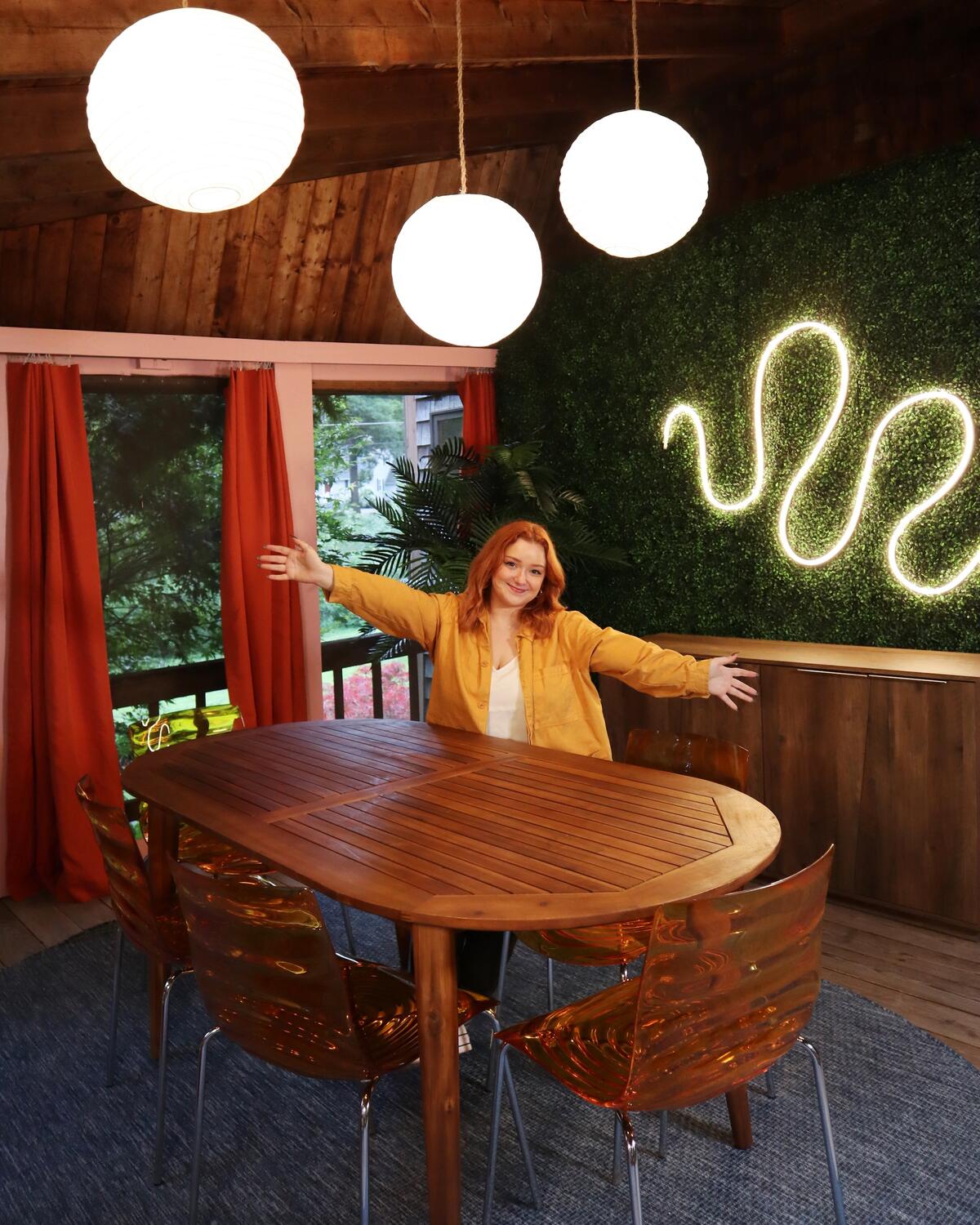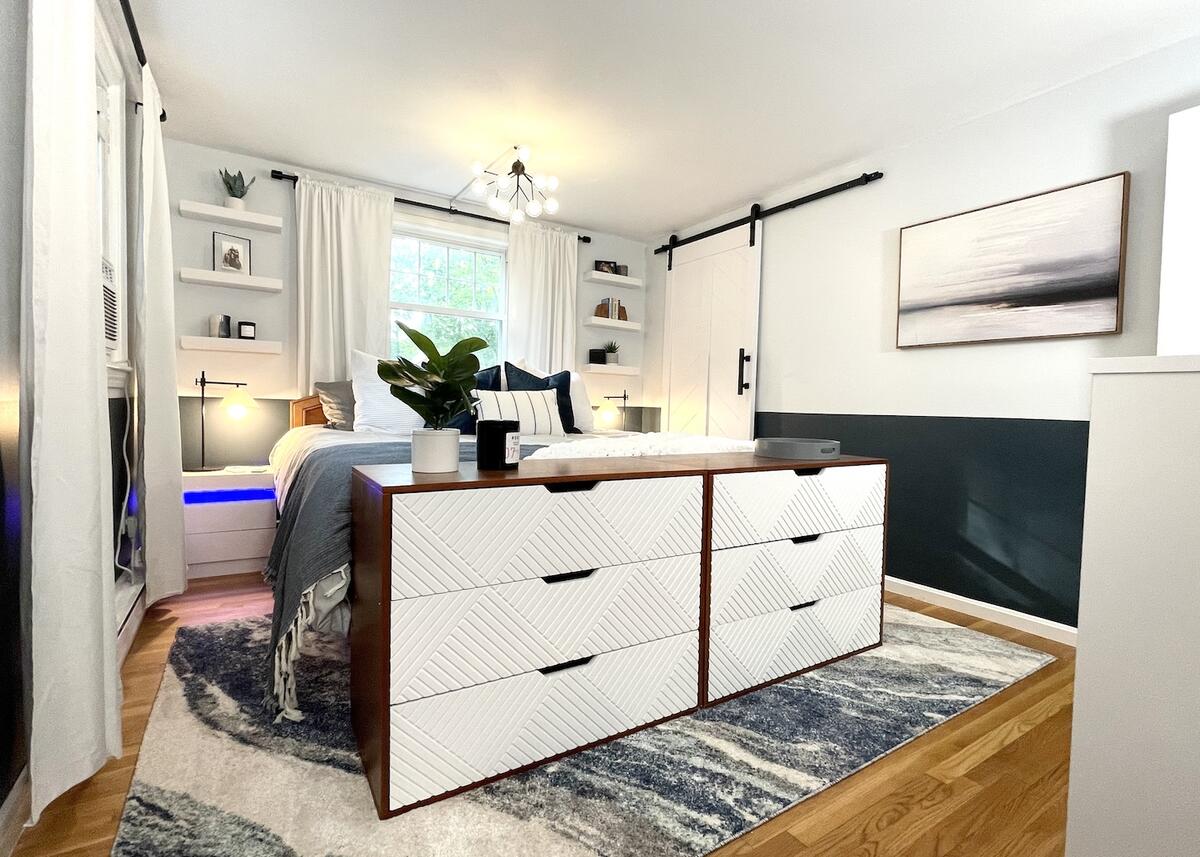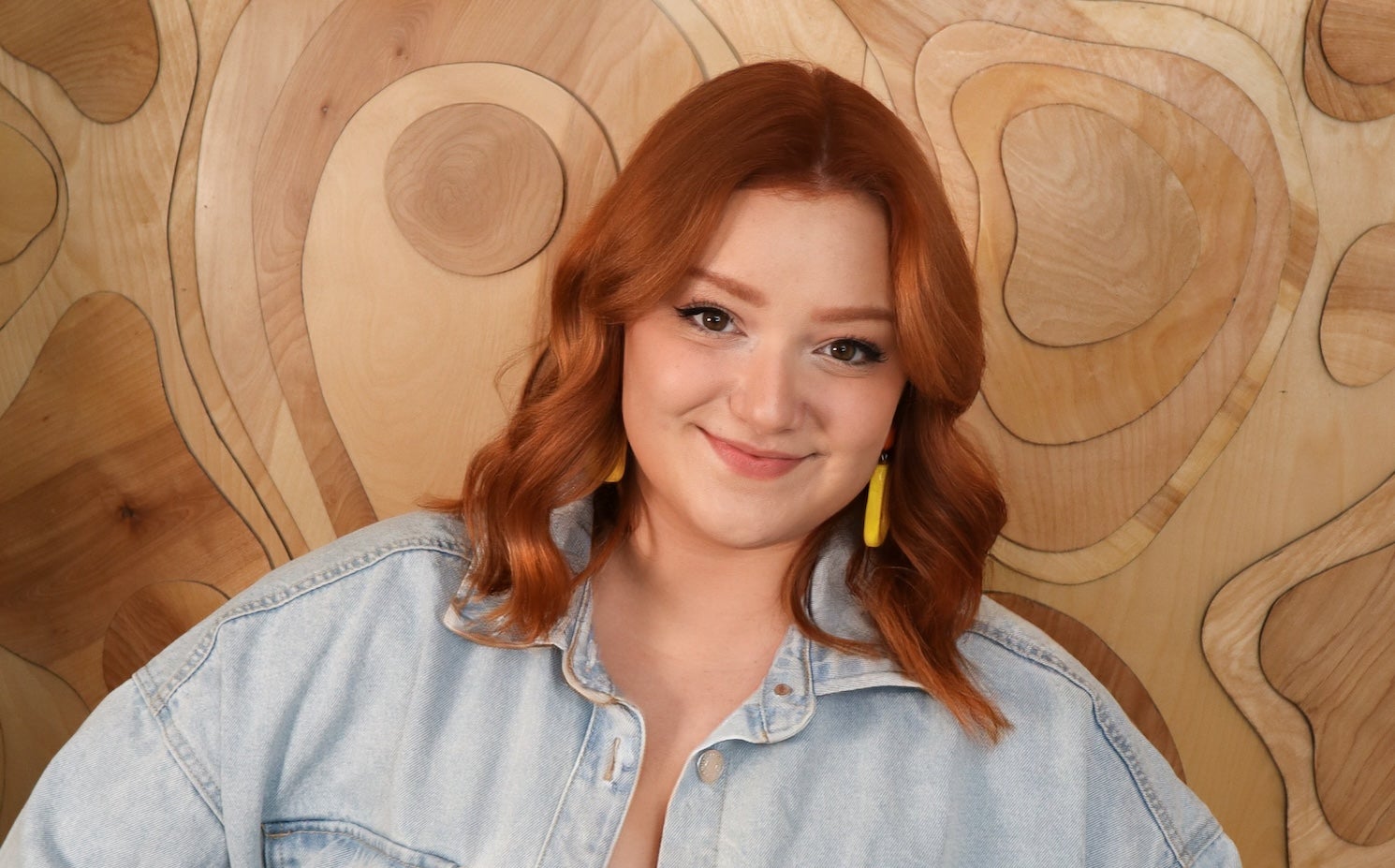In Ask an Influencer, Business of Home explores the creator economy. This week, we spoke with Massachusetts-based interior designer and TikTok home renovator Emily Rayna.
Emily Rayna had done everything right. Her undergraduate years in an interior architecture program were a blur of part-time jobs, scholarship applications and networking with industry professionals who could help her get a foot in the door. The hard work paid off when she landed an internship at Gensler upon graduation—but in a matter of months, it all disappeared. The pandemic hit, and Rayna was laid off immediately. Faced with a sudden blank period on an otherwise meticulously planned career map, she decided to take her friends up on their suggestions to join TikTok.
“My parents have this old, pretty outdated house that was built in the 1970s, and I just so happen to be an interior designer—and they just so happen to be away for the month,” Rayna says in her first video. With their permission, she undertook the project of transforming the house on an “extremely tight” budget. The stakes were high: The first video, simply announcing the project, hit a million views nearly overnight.
Rayna delivered on her promise, documenting all the decluttering, repainting, furniture hunting and even structural changes along the way. The dozens of videos that led to the project’s stunning completion each racked up view counts in the millions. And Rayna didn’t stop there—she began documenting a series of “extreme budget home makeover” projects, eventually capturing the eye of internet celebrities like MrBeast and Hank Green, who became her design clients. Today, she has a following of 5.9 million on TikTok and 444,000 on Instagram.
Ahead, Rayna shares how teaming up with other creators has multiplied her online reach, how her filming strategy maximizes her content production for multiple platforms and why she has hired a lawyer to screen all of her brand partnerships.
When did you find a content strategy that worked for you?
When my parents’ renovation happened, it was the very first video that I posted. I woke up the next morning and had like 100,000 followers—and that was a lot for me, because before all of this, I was someone who would post on Instagram like once a month, or just to make a birthday post. It was really overwhelming, so I just tried to take it as it went. I’m someone who likes challenges, so it felt like a really big challenge, and I just kept going. By the end of the month, I had like 3 million followers. This was a crazy time for TikTok, when people could grow so quickly, so it was a very fast process. I would have never been someone who continuously tried to become a content creator—that was never my avenue. I was always so interested in architecture and going that direction, but when this opportunity placed itself in front of me, I was like, “I can reach so many more people with my designs and do something still in the design field, but with social media.” It’s been really exciting to take that journey.
A lot of it has to do with the time that I joined TikTok. I was one of the first interior design creators on the app, and then, in addition to people knowing my story and my architectural background, it created this sense of trust with my audience. I give them sound design advice because I went to school for it, [and I also appeal to them] because my beginning story was incredibly emotional on social media—I was sharing my parents’ hardship and my hardship basically to create my own persona, so people felt really comfortable sharing their own stories in the DMs. So, there’s a logistical connection, but also an emotional connection.
Once that project was over, how did you decide what to start posting next?
I honestly had no idea what to do. I was never a marketer or content strategist, and I had people commenting, asking me to start a YouTube channel and post more videos because they loved the budget DIY tips and tricks. I decided to just keep going, posting renovation content or other DIY tricks, or going to my other family members and being like, “Can I work on this room for you? People really want me to do another renovation.” And they’d be like, “Yeah.” Or I would just share general architectural knowledge that I had from school and try to make it in a fun format for people to take in, and people really liked that. Eventually, I had management reaching out to me, and that’s when I realized, “Wait, this can actually be a job.” That was a whole other process because I was so scared to sign on for that and not be in the architecture field anymore. I was so set in my ways, but I ended up just taking it as a game, and I just went with it.

How does your business factor into your content, and where did that begin?
I didn’t know a lot about making money on social media, and I didn’t believe that it was possible for someone like me. I was just passion posting, and I was really excited because I had so many people engaging and there was a great community. When management started reaching out, I picked Select [Management Group], and we started talking and my manager Brittany [Maxwell] started getting me all of the brand deals and explaining how to do it and how to communicate and everything. I would not have a career in social media without them. They’ve really helped me a lot. But I didn’t do anything before that. I got a lot of emails from different brands and stuff, but I was just so overwhelmed, and I didn’t know how to do contracts. I just kind of waited.
Would you recommend other designers or content creators work with management?
One thousand percent. I think when we go to school for design, they don’t teach you these types of things. Although you can read through a contract and think that you understand it, there are these little clauses all the time—you could be selling your whole name to this brand; you could be giving up your content. Even if you don’t have management yet, it’s really important to have a lawyer look over your contracts. I have a lawyer now who looks over mine as well. If you’re not protected, you could really ruin your career.
The second that I signed on with management, way back in the beginning, they were asking me, “What do you want out of this career?” The thing that I leaned toward most was that it would be so cool if I could develop products, because just the idea of having a product that I created in stores, and going to a Walmart or Target and seeing the product that I created—I would just pass out on the spot. That was what really inspired me to be able to do something like that. They’ve always known that, so they’ve been looking for those [opportunities], and a long time ago, we got an email from the RoomMates brand—they are so well known and really good quality and affordable. They reached out wanting to do a collaboration, so [my team] did a lot of work on that, trying to figure out what I wanted for it and timelines and everything. That’s been really exciting, and I’m starting to dip my feet into the waters of [product] creation in general … and I’m excited to do more in the future.
Do you take on design clients too?
It’s a case-by-case basis on that front. Most of my income comes from brand deals, which is incredibly lucrative for me, but I do, here and there, have client projects that pay. A lot of [these] are collaborations with other influencers, so I will take the time and energy to create a design for them, and then they take the time and energy to bring that design to life on their own. It’s a mutual collaboration—it’s like a Disney Channel crossover, and people are excited that these influencers met each other.
When I do designs for people who follow me, it’s completely free. I’m adamant about that because I wouldn’t have anything that I have right now without the people who are supporting me. When people are reaching out to me for help with their space, it’s typically in a case of need; it’s not in a place of, “I’m ready to pay a designer.” Whenever I do designs for people on social media and share those tips, it’s just as a thank-you, and I’ll do it in my free time. But there are projects where I’m working with an influencer, a celebrity or [other] client … and they insist on paying me for my time, so it’s different every single time—but it’s not something that I like to look at as an income stream. It’s something that I like to keep as more of a passion.
How much of your personal life do you share on social media?
I don’t share a whole lot of my personal life. It seems like I share a lot of it, but the only personal life stuff I share is in regards to interior design. [When I’ve shared my] struggles, it’s all home related. I think that that stuff is really important because interior design has always been a very strict field. It’s always been something that’s very hard to achieve, that a lot of people shy away from because it’s very high stakes. I want to break that wall. I want people to know that with interior design, you can have it in all of these different ways, and it doesn’t have to be something that’s really hard—but it also can be really hard.
I think seeing someone who’s a professional in the field struggling with these things and feeling these emotions is really validating to the people who follow me, who are trying to do these DIYs and design their space and feel really overwhelmed. So I like to share that stuff. I like to share the stories of the people I’m designing for, if they’re willing. I like to share a few of my family members who’ve been there when I’m designing for them, because they’ve got great personalities. But for the most part, everything else is completely private. I really love that, because I can have my little dual life—my interior design life and my personal life.
What do you do when you’re stumped for inspiration?
I wouldn’t say that I’m ever stumped—I have so many video ideas; it’s just about finding the time to execute them. I’m a designer first, and I get really jazzed up about that stuff, and I have, like, lists upon lists of things I want to do. The struggle for me is finding the time, because I think that my job is a lot more time-consuming than the typical influencer’s: I not only have to do the physical renovations, but I also have to do the computer work to show a visual for the renovations, then I have to film the content, edit the content, get it out there, and communicate and stuff. Those are things that I’m working toward outsourcing, but I’m so particular about certain things and I love doing them—for example, I don’t want the architecture things to be stripped away from me. I want to use those programs. So it’s a whole give-and-take.
Right—you’re basically producing your own HGTV show. Do you have a team that helps you?
I have my management, and they are really great at emails and communication and keeping that stuff organized for me, because if I had to do that, I would just be drowning. I also have my partner, who is working for me full-time, so Lu does filming for me and does business logistics, such as helping me find all the video files when I need them. … In college, I did tutoring for a lot of girls [who now] actually know how I build things online, so I’ve hired a lot of them on here and there to help me get renders out quickly and show visuals of a space. It’s on an as-needed basis, but in the future, I definitely want a full-time editor and stuff like that.

What does the physical process of producing content look like for you?
I have a Canon camera that I’ll take out when I’m sitting down for a long-form video, but most of the time, I’m on the go. I can’t pull out my camera and lighting equipment when I’m doing a renovation—renovations already take significantly longer when you’re trying to film every single step. What I’ve actually done is kept one of my old phones, and so I have two cell phones, and on one of them, I film in horizontal [for YouTube], and the other, I film vertical [for Instagram and TikTok.] I usually have two tripods or Lu filming me. Then I use CapCut on my phone to edit, and for long-form video, I send it over to my computer, and I’ll use either Final Cut or iMovie when I’m in a really big rush.
What’s something you’re analyzing about your business right now on social media?
One of my biggest struggles right now—and always—on social media has been trying to find my identity. I struggle a lot because I’ve had a lot of poor experiences with people—because my collaborations and projects are very much providing a service to someone else, there have been a lot of times when I’ve been fully walked all over. Some have been so bad that I look at the experience afterward and I’m like, “Why am I doing this? I can just go do design at a firm and [not] be put in these compromising situations.” I’ve also met people in the industry and I’m like, “I don’t want to be like that person. I don’t want content creation to be my goal.” So, trying to forge my identity online involves feeling like I’m doing something good instead of adding to the whole cycle of social media becoming addicting.
I’m also trying to figure out how much I want to share so that I don’t create too hard of a parasocial relationship with people online—I want people to come to me as a resource instead of drama or tea or whatever. I was never a social media person, and it’s definitely a hard field to be in when you’re not that social media savvy, to be honest. But I think it’s just trying to find my identity and trying not to feel discouraged. Because, I could go work at a firm like Gensler and be able to do the fun designs and not have so much social pressure, but I use social media for the good community that I have, and I try to think about the people in my DMs and the ones I’m talking to to try to forget about some of those bad experiences.
I [hope] that I’m able to keep creating content on social media platforms, because I love connecting with people directly like this, but I also have other goals too. Product creation is my main goal. I have so many cool ideas for renter-friendly things that people can have and stuff like that. So we’re leaning into that and looking at different avenues—we’ve been thinking about a book for a while. I have a lot of random goals: I want to open a hotel where every room is a different style; I want to do all different kinds of stuff.
It’s a learn-as-you-go type of thing. I just have to adjust every day based on the ebbs and flows. My goal is to connect the bridge between standard design and architecture and the average everyday person, to be renowned in that field while not having such a strict trajectory. And [I’m in it] for the people, of course—I want to help people.





























